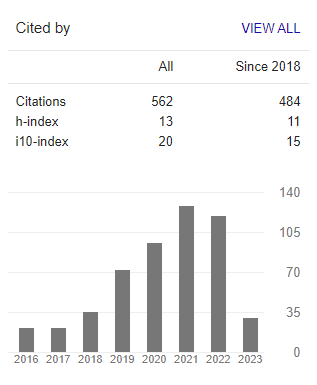SEMIOTIC ANALYSIS OF THE LOVE MYSELF MESSAGE IN THE BTS SONG LYRICS 'EPIPHANY'
Abstract
The song is one of the communication media that can spread messages. In a song lyric, there is a meaning to be conveyed from the creator and singer to the audience. This study determines the meaning of the message of love myself, raised by the South Korean boyband, BTS, through their song entitled Epiphany. 4 aspects of self-love must be met by someone to love oneself, namely self-awareness, self-worth, self-esteem, and self-care. This study examines whether the Epiphany song sung by BTS contains these four aspects of self-love. This research uses Ferdinand de Saussure's semiotic analysis method. The data were analyzed by determining the signifier and the signified in the lyrics of the Epiphany song. The findings show that the song Epiphany lyrics contain four self-love aspects. Self-awareness is a person's awareness that comes from the individual's thought process. The song's lyrics describe how a person begins to realize and begins to ask himself that his attitude in living life is not as it should be. The next stage is self-worth, when a person has confidence in himself. The lyrics of the song, it is described the emergence of awareness that he is valuable regardless of the shortcomings he has. The third stage of self-love is self-esteem, where an individual feels satisfied with himself and comfortable with the conditions that exist in himself and his environment. In the song lyrics, it is described that a person is aware of loving himself and accepting himself as he is. The self-care stage is the last stage where in the song lyrics, it is described that a person must take care of themselves by not hurting themselves physically and psychologically
To cite this article (7th APA style):
Larasati, M. F., Daniar, A., & Marta, R. F. (2022). Semiotic analysis of the love myself message in the BTS song lyrics "epiphany". Journal Communication Spectrum: Capturing New Perspectives in Communication 12(1), 68-76. https://doi.org/10.36782/jcs.v12i1.2183
Keywords
References
Hofmann, W., Sedikides, C., Gebauer, J. E., & Go, A. S. (2012). Self-love or other-love? Explicit other-preference but implicit self-preference. PLoS ONE, 7(7), 1–6. https://doi.org/10.1371/journal.pone.0041789
Iabu, A. F. (2021, February 12). Fenomena bunuh diri di Korea Selatan, ini kata pakar epidemiologi sosial. VOI.ID. https://voi.id/berita/32735/fenomena-bunuh-diri-di-korea-selatan-ini-kata-pakar-epidemiologi-sosial
Khoshaba, D. (2012). A seven-step prescription for self-love. Psychology Today. https://www.psychologytoday.com/us/blog/get-hardy/201203/seven-step-prescription-self-love.
Lestari, A. F., & Irwansyah, I. (2020). Participative fandom by army BTS Indonesia in the digital comic of webton apps. Journal Communication Spectrum, 10(1). https://doi.org/10.36782/jcs.v9i1.1872
Lestari, S. K., & Saidi, A. I. (2020). Semiotika “kampanye love myself” grup penyanyi Korea BTS (Studi kasus : Video comeback trailer ‘epiphany’). Jurnal Komunikasi Visual Wimba, 11(2), 24–37.
Littlejohn, S. W., & Foss, K. A. (2011). Teori komunikasi (9th ed.). Salemba Humanika.
Gaol, N. T. L. (2016). Teori stres: Stimulus, respons, dan transaksional. Buletin Psikologi, 24(1), 1. https://doi.org/10.22146/bpsi.11224
Miftahurrezki, & Anshori, M. S. (2021). Analisis makna pesan motivasi dalam lirik lagu kpop BTS answer: Love myself. Kaganga Komunika: Journal of Communication Science, 3(1), 69–81.
Morissan. (2013). Teori komunikasi individu hingga massa. Kencana Prenada Media.
Mukarromah, L., Nuqul, F. L. (2014). Dinamika psikologis pada pelaku percobaan bunuh diri. Jurnal Psikoislamika, 11(2), 31–36.
Mutiah, D. (2021). Kembali digandeng UNICEF, BTS kini suarakan love myself untuk setop kekerasan pada anak. Liputan 6. https://www.liputan6.com/lifestyle/read/4498944/kembali-digandeng-unicef-bts-kini-suarakan-love-myself-untuk-setop-kekerasan-pada-anak
Mutiwasekwa, S. L. (2019). Self-Love. Psychology Today.
Nathaniel, A., & Sannie, A. W. (2018). Analisis semiotika makna kesendirian pada lirik lagu “ruang sendiri” karya Tulus. Semiotika: Jurnal Ilmu Sastra dan Linguistik, 19(2), 107–117.
Nugraha, R. P. (2016). Konstruksi nilai-nilai nasionalisme dalam lirik lagu (Analisis semiotika Ferdinand de Saussure pada lirik lagu “bendera”). Jurnal Ilmu Ekonomi Dan Sosial, 5(3), 290–303.
Prasetya, A. B. (2019). Analisis semiotika film dan komunikasi. Intrans Publishing.
Rakhmat, J. (2013). Psikologi komunikasi (29th ed.). PT Remaja Rosdakarya.
Ramadhiani, S. N., & Pramonojati, T. A. (2021). Makna motivasi pada lirik lagu “merakit” karya Yura Yunita (Studi semiotika Ferdinand de Saussure). E-Proceeding of Management, 8(1), 548–560.
Safira, B. A., & Badaruddin, M. (2021). Cyber traveling and cinematic reality: Experiences of the k-drama fans. Journal Communication Spectrum, 11(1), 84–94. https://doi.org/10.36782/jcs.v11i1.2150
Setyanti, C. A. (2021). Masuk nominasi Grammy Awards 2021, BTS cetak sejarah. CNN Indonesia. https://www.cnnindonesia.com/hiburan/20201125015515-227-574053/masuk-nominasi-grammy-awards-2021-bts-cetak-sejarah
Winduwati, S. (2012). Representasi seks bebas pada lirik lagu dangdut (Analisis semiotika Saussure pada lirik lagu “cinta satu malam”). Jurnal Muara Ilmu Sosial, Humaniora, Dan Seni, 1(2), 346–359.
Yuliarti, M. S. (2015). Komunikasi musik: Pesan nilai-nilai cinta dalam lagu Indonesia. Jurnal Ilmu Komunikasi, 12(2). https://doi.org/10.24002/jik.v12i2.470
Refbacks
- There are currently no refbacks.

This work is licensed under a Creative Commons Attribution 3.0 License.
Indexed by:
Archived in:
Listed in:
INTERNATIONAL ASSOCIATION FOR MEDIA AND COMMUNICATION RESEARCH

















